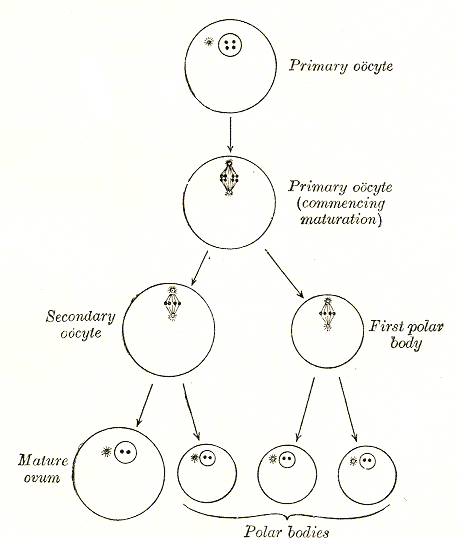|
X-inactivation
X-inactivation (also called Lyonization, after English geneticist Mary Lyon) is a process by which one of the copies of the X chromosome is inactivated in therian female mammals. The inactive X chromosome is silenced by being packaged into a transcriptionally inactive structure called heterochromatin. As nearly all female mammals have two X chromosomes, X-inactivation prevents them from having twice as many X chromosome gene products as males, who only possess a single copy of the X chromosome (see dosage compensation). The choice of which X chromosome will be inactivated in a particular embryonic cell is random in placental mammals such as humans, but once an X chromosome is inactivated it will remain inactive throughout the lifetime of the cell and its descendants in the organism (its cell line). The result is that the choice of inactivated X chromosome in all the cells of the organism is a random distribution, often with about half the cells having the paternal X chrom ... [...More Info...] [...Related Items...] OR: [Wikipedia] [Google] [Baidu] |
Skewed X-inactivation
Skewed X-chromosome inactivation (skewed X-inactivation) occurs when the X-inactivation of one X chromosome is favored over the other, leading to an uneven number of cells with each chromosome inactivated. It is usually defined as one allele being found on the active X chromosome in over 75% of cells, and extreme skewing is when over 90% of cells have inactivated the same X chromosome. It can be caused by primary nonrandom inactivation, either by chance due to a small cell pool or directed by genes, or by secondary nonrandom inactivation, which occurs by selection. X-chromosome inactivation occurs in females to provide dosage compensation between the sexes. If females kept both X chromosomes active, they would have twice the number of active X genes than males, who only have one copy of the X chromosome. At approximately the time of embryonic implantation, one of the two X chromosomes in each cell of the female embryo is randomly selected for inactivation. Cells then undergo tra ... [...More Info...] [...Related Items...] OR: [Wikipedia] [Google] [Baidu] |
Dosage Compensation
Dosage compensation is the process by which organisms equalize the expression of genes between members of different biological sexes. Across species, different sexes are often characterized by different types and numbers of sex chromosomes. In order to neutralize the large difference in gene dosage produced by differing numbers of sex chromosomes among the sexes, various evolutionary branches have acquired various methods to equalize gene expression among the sexes. Because sex chromosomes contain different numbers of genes, different species of organisms have developed different mechanisms to cope with this inequality. Replicating the actual ''gene'' is impossible; thus organisms instead equalize the ''expression'' from each gene. For example, in humans, female (XX) cells randomly silence the transcription of one X chromosome, and transcribe all information from the other, expressed X chromosome. Thus, human females have the same number of expressed X-linked genes per cell as ... [...More Info...] [...Related Items...] OR: [Wikipedia] [Google] [Baidu] |
Sex Linkage
Sex linkage describes the sex-specific patterns of inheritance and expression when a gene is present on a sex chromosome (allosome) rather than a non-sex chromosome ( autosome). Genes situated on the X-chromosome are thus termed X-linked, and are transmitted by both males and females, while genes situated on the Y-chromosome are termed Y-linked, and are transmitted by males only. As human females possess two X-chromosomes and human males possess one X-chromosome and one Y-chromosome, the phenotype of a sex-linked trait can differ between males and females due to the differential number of alleles (polymorphisms) possessed for a given gene. In humans, sex-linked patterns of inheritance are termed X-linked recessive, X-linked dominant and Y-linked. The inheritance and presentation of all three differ depending on the sex of both the parent and the child. This makes sex-linked patterns of inheritance characteristically different from autosomal dominance and recessiveness. T ... [...More Info...] [...Related Items...] OR: [Wikipedia] [Google] [Baidu] |
X-chromosome Reactivation
X chromosome reactivation (XCR) is the process by which the inactive X chromosome (the Xi) is re-activated in the cells of eutherian female mammals. Therian female mammalian cells have two X chromosomes, while males have only one, requiring X-chromosome inactivation (XCI) for sex-chromosome dosage compensation. In eutherians, XCI is the random inactivation of one of the X chromosomes, silencing its expression. Much of the scientific knowledge currently known about XCR comes from research limited to mouse models or stem cells. Partial XCR may derepress one or more genes on the Xi, and the level of restored gene expression may not be as high as it would normally be on the active X chromosome (the Xa). Complete XCR restores the Xi to Xa and erases the epigenetic memory of XCI, meaning that inducing X-inactivation again will randomly select an X chromosome to silence, rather than deterministically silencing the original Xi. XCR is an emerging topic of interest for multiple reasons: ... [...More Info...] [...Related Items...] OR: [Wikipedia] [Google] [Baidu] |
X Chromosome
The X chromosome is one of the two sex chromosomes in many organisms, including mammals, and is found in both males and females. It is a part of the XY sex-determination system and XO sex-determination system. The X chromosome was named for its unique properties by early researchers, which resulted in the naming of its counterpart Y chromosome, for the next letter in the alphabet, following its subsequent discovery. Discovery It was first noted that the X chromosome was special in 1890 by Hermann Henking in Leipzig. Henking was studying the testicles of '' Pyrrhocoris'' and noticed that one chromosome did not take part in meiosis. Chromosomes are so named because of their ability to take up staining (''chroma'' in Greek means ''color''). Although the X chromosome could be stained just as well as the others, Henking was unsure whether it was a different class of the object and consequently named it ''X element'', which later became X chromosome after it was established that it w ... [...More Info...] [...Related Items...] OR: [Wikipedia] [Google] [Baidu] |
Tortoiseshell Cat
Tortoiseshell is a cat animal coloration, coat coloring named for its similarity to tortoiseshell pattern. Like tortoiseshell-and-white or Calico cat, calico cats, tortoiseshell cats are almost exclusively female. Male tortoiseshells are rare and are usually sterile.Atkins (2003), p.105 Tortoiseshell cats, or torties, combine two colors other than white, either closely mixed or in larger patches. The colors are often described as red and black, but the "red" patches can instead be orange, yellow, or cream, and the "black" can instead be chocolate, gray, tabby cat, tabby, or blue. Tortoiseshell cats with the tabby cat, tabby pattern as one of their colors are sometimes referred to as torbies or torbie cats. "Tortoiseshell" is typically reserved for multicolored cats with relatively small or no white markings. Those that are predominantly white with tortoiseshell patches are described as tricolor, tortoiseshell-and-white, or calico cat, calico. Tortoiseshell markings appear in m ... [...More Info...] [...Related Items...] OR: [Wikipedia] [Google] [Baidu] |
Heterochromatin
Heterochromatin is a tightly packed form of DNA or '' condensed DNA'', which comes in multiple varieties. These varieties lie on a continuum between the two extremes of constitutive heterochromatin and facultative heterochromatin. Both play a role in the expression of genes. Because it is tightly packed, it was thought to be inaccessible to polymerases and therefore not transcribed; however, according to Volpe et al. (2002), and many other papers since, much of this DNA is in fact transcribed, but it is continuously turned over via RNA-induced transcriptional silencing (RITS). Recent studies with electron microscopy and OsO4 staining reveal that the dense packing is not due to the chromatin. Constitutive heterochromatin can affect the genes near itself (e.g. position-effect variegation). It is usually repetitive and forms structural functions such as centromeres or telomeres, in addition to acting as an attractor for other gene-expression or repression signals. Facultativ ... [...More Info...] [...Related Items...] OR: [Wikipedia] [Google] [Baidu] |
Blastocyst
The blastocyst is a structure formed in the early embryonic development of mammals. It possesses an inner cell mass (ICM) also known as the ''embryoblast'' which subsequently forms the embryo, and an outer layer of trophoblast cells called the trophectoderm. This layer surrounds the inner cell mass and a fluid-filled cavity or lumen known as the blastocoel. In the late blastocyst, the trophectoderm is known as the trophoblast. The trophoblast gives rise to the chorion and amnion, the two fetal membranes that surround the embryo. The placenta derives from the embryonic chorion (the portion of the chorion that develops villi) and the underlying uterine tissue of the mother. The corresponding structure in non-mammalian animals is an undifferentiated ball of cells called the blastula. In humans, blastocyst formation begins about five days after fertilization when a fluid-filled cavity opens up in the morula, the early embryonic stage of a ball of 16 cells. The blastocyst ... [...More Info...] [...Related Items...] OR: [Wikipedia] [Google] [Baidu] |
Inner Cell Mass
The inner cell mass (ICM) or embryoblast (known as the pluriblast in marsupials) is a structure in the early development of an embryo. It is the mass of cells inside the blastocyst that will eventually give rise to the definitive structures of the fetus. The inner cell mass forms in the earliest stages of embryonic development, before implantation into the endometrium of the uterus. The ICM is entirely surrounded by the single layer of trophoblast cells of the trophectoderm. Further development The physical and functional separation of the inner cell mass from the trophectoderm (TE) is a special feature of mammalian development and is the first cell lineage specification in these embryos. Following fertilization in the oviduct, the mammalian embryo undergoes a relatively slow round of cleavages to produce an eight-cell morula. Each cell of the morula, called a blastomere, increases surface contact with its neighbors in a process called compaction. This results in a polari ... [...More Info...] [...Related Items...] OR: [Wikipedia] [Google] [Baidu] |
Oocyte
An oocyte (, oöcyte, or ovocyte) is a female gametocyte or germ cell involved in reproduction. In other words, it is an immature ovum, or egg cell. An oocyte is produced in a female fetus in the ovary during female gametogenesis. The female germ cells produce a primordial germ cell (PGC), which then undergoes mitosis, forming oogonia. During oogenesis, the oogonia become primary oocytes. An oocyte is a form of genetic material that can be collected for cryoconservation. Formation The formation of an oocyte is called oocytogenesis, which is a part of oogenesis. Oogenesis results in the formation of both primary oocytes during fetal period, and of secondary oocytes after it as part of ovulation. Characteristics Cytoplasm Oocytes are rich in cytoplasm, which contains yolk granules to nourish the cell early in development. Nucleus During the primary oocyte stage of oogenesis, the nucleus is called a germinal vesicle. The only normal human type of secondary oocyte has the ... [...More Info...] [...Related Items...] OR: [Wikipedia] [Google] [Baidu] |
Germline
In biology and genetics, the germline is the population of a multicellular organism's cells that develop into germ cells. In other words, they are the cells that form gametes ( eggs and sperm), which can come together to form a zygote. They differentiate in the gonads from primordial germ cells into gametogonia, which develop into gametocytes, which develop into the final gametes. This process is known as gametogenesis. Germ cells pass on genetic material through the process of sexual reproduction. This includes fertilization, recombination and meiosis. These processes help to increase genetic diversity in offspring. Certain organisms reproduce asexually via processes such as apomixis, parthenogenesis, autogamy, and cloning. Apomixis and Parthenogenesis both refer to the development of an embryo without fertilization. The former typically occurs in plants seeds, while the latter tends to be seen in nematodes, as well as certain species of reptiles, birds, and fish. Autogamy ... [...More Info...] [...Related Items...] OR: [Wikipedia] [Google] [Baidu] |




